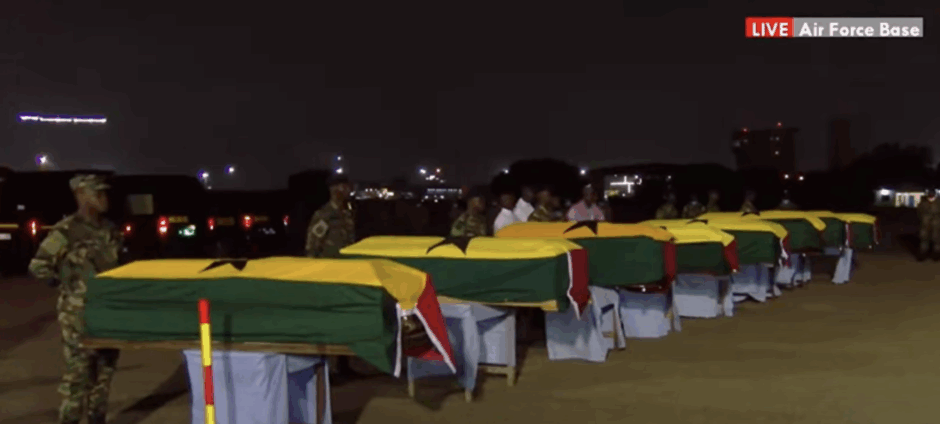Ghana must Act, Harbin Z-9 crash exposed Ghana’s deadly fleet failures


The official report on the August 6, 2025, Harbin Z-9EH helicopter crash, which tragically claimed the lives of eight individuals, including Ghana’s Defence and Environment Ministers, offers definitive technical closure while opening a sobering chapter on systemic safety deficiencies. The conclusion that a sudden and powerful downdraft over rugged, forested terrain was the immediate catalyst for the loss of altitude and lift is undeniable.
However, Captain Paul Fordjour, the lead investigator, and his committee’s findings also unveil a critical intersection of adverse weather, challenging geography, and an aircraft fleet lacking modern safety architecture. This tragic event moves beyond a simple accident; it becomes a poignant case study in national aviation preparedness and the high-stakes risks borne by high-level government officials.
Competence Confirmed, Technology Found Wanting
The report strongly asserts that the flight crew was fully competent and healthy, ruling out human error. The crew included Squadron Leader Peter Bafemi Anala (Captain), Flying Officer Manaen Twum Ampadu (Co-Pilot), and Sergeant Ernest Addo Mensah (Flight Engineer). The Captain held a postgraduate certificate in Safety and Accident Investigation and was a qualified FAA Commercial and Instrument-rated pilot. The catastrophe was fundamentally an aerodynamic failure caused by an overwhelming natural force.
“The investigation determined that the accident was caused by the sudden loss of altitude and lift due to downdraft,” Captain Fordjour stated. This aerodynamic failure occurred “without change in power or pitch attitude,” meaning the downdraft literally pushed the serviceable helicopter out of the sky. The flight recorder was recovered, confirming this sequence of events.
Yet, the comprehensive probe highlights that while nature delivered the blow, systemic vulnerabilities amplified the risk. The Harbin Z-9EH (tail number GHF 631), a 12-year-old Chinese-manufactured military utility helicopter, though airworthy, lacked crucial safety features. Key missing equipment included Terrain Awareness and Warning Systems (HTAWS/EGPWS) and an Automatic Flight Control System (AFCS). These are standard modern safety tools specifically designed to assist pilots in avoiding controlled flight into terrain scenarios, especially when navigating rising ground in low visibility. The absence of these systems is a profound and arguably preventable safety gap in the fleet used to transport the nation’s leadership.
Critical Gaps in Flight Safety Infrastructure
The investigation underscored the severely limited environmental information available to the crew. The flight was delayed for over an hour, taking off at 9:12 a.m. instead of 8:00 a.m., due to poor weather.
However, conditions along the route continued to be hazardous, described by Captain Fordjour as “mist, drizzle, and low clouds affecting flight operations,” with visibility dropping to as low as 200 meters. Crucially, the crew only had aerodrome weather reports for Accra and Kumasi. The flight path lacked en route weather services and ground-based navigational aids.
This forced the pilots, who began under Visual Flight Rules (VFR) in marginal conditions, to transition to Instrument Flight Rules (IFR) just minutes before impact. The lack of real-time weather and terrain data meant the crew was essentially fighting an unseen, lethal foe in a poorly charted environment.
This is a critical national security issue, as one ordinary Ghanaian, Kofi Mensah, remarked, “Our leaders deserve the best technology; they carry the country on their shoulders.
This should never happen again.” Another local resident, Adwoa Fosua, commented, “The downdraft is nature, but the missing safety equipment is a choice. We must ask why our Air Force lacks the basics.”
National Mourning, The Enduring Human Toll
The death of two prominent government ministers, Dr. Edward Omane Boamah (Defence) and Dr. Ibrahim Murtala Muhammed (Environment), alongside senior officials, is an immeasurable loss to the nation’s political and administrative landscape.
The victims included Muniru Mohammed Limuna, the Acting Deputy National Security Coordinator, Dr. Samuel Sarpong, the Vice-Chairman of the National Democratic Congress, and Samuel Aboagye, a former parliamentary candidate.
Their mission to a gold-mining area to discuss the fight against illegal mining underscores the high-risk, consequential work they were undertaking when their lives were cut short. The report mentioned the victims were “burnt beyond recognition in a post-crash fire,” explaining that the Z-9’s fully-loaded fuel tanks were located directly under the passengers’ sitting area and exploded on impact. This harrowing detail speaks to the violence of the impact and the profound grief it inspired, necessitating DNA samples to be flown to South Africa for forensic identification. A state funeral was held in Accra on August 15, 2025, to honor the fallen.
Former pilot and aviation expert, Dr. Ebo Quansah, speaking on the findings, stated, “The report is a necessary first step, but the true impact is the hole left in the government.
The human cost of these systemic shortfalls is eight lives and the future they represented.” The final images of the wreckage, “debris on fire in a forest,” serve as a stark reminder of the volatile risks inherent in the essential, but often overlooked, aviation infrastructure supporting the state.
Time for Action, Safety Reforms Must Follow
The findings are a direct challenge to the government, which requested the report from President John Dramani Mahama.
The revelations regarding the absence of Flight Data Monitoring (FDM), real-time tracking systems, and simulator training for crews point to critical institutional shortcomings within the Ghana Air Force’s operational oversight.
The investigative committee, led by Captain Paul Forjoe, issued several explicit and critical recommendations.
These must include: Acquiring modern aircraft fitted with terrain avoidance warning systems; installing voice recorders and audiovisual-capable flight data recorders; investing in certified simulators for recurrent pilot training; developing en-route navigational aids, especially for remote operational routes; and establishing a flight data monitoring and real-time tracking system.
The immediate focus must pivot from explaining the crash to enacting comprehensive safety reforms. The government must now provide a clear timeline and funding commitment for these recommendations to demonstrate tangible accountability for the systemic failures identified.
The technical findings have provided the definitive answer, but the political and military response now dictates whether this tragedy serves as a catalyst for a safer future or remains a devastating, preventable loss. As one family member of a crash victim stated, “We have the answer, but the real closure will come when we know our leaders have acted on these warnings, not just received the report.”
DISCLAIMER: The Views, Comments, Opinions, Contributions and Statements made by Readers and Contributors on this platform do not necessarily represent the views or policy of Multimedia Group Limited.
DISCLAIMER: The Views, Comments, Opinions, Contributions and Statements made by Readers and Contributors on this platform do not necessarily represent the views or policy of Multimedia Group Limited.
Source link





